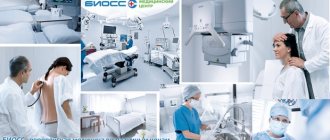Vegetovascular dystonia (or VSD for short) is a psychosomatic problem in which the functioning of the autonomic system, which is responsible for balance in the body, is disrupted. At the same time, the circulatory system “fails”, blood pressure and vascular tone decrease - therefore, all organs receive the necessary substances in smaller quantities than required. This leads to disastrous consequences, such as blood stagnation, brain hypoxia, and decreased organ activity. One of the varieties of this disorder is VSD of the hypotonic type. It is characterized by disruption of the cardiovascular system, decreased blood pressure, and decreased blood flow to all organs.
Young people who lead a sedentary lifestyle are more often susceptible to VSD of the hypotonic type. But this type of vegetative-vascular dystonia can also affect the older generation.
Types of vegetative-vascular dystonia (VSD)
Depending on how the cardiovascular system reacts to a disorder of the autonomic nervous system, 4 types of VSD are conventionally distinguished: hypertensive, hypotonic, cardiac and mixed. A more detailed study of the signs of vegetative-vascular dystonia made it possible to identify 3 more types of disorder: vagotonia, cerebral-type VSD and somatoform dysfunction.
This typology is outdated, however, it allows you to classify all symptoms of VSD. The problem of diagnosing autonomic dysfunction is acute, and patients often become victims of ignorance or inattention of doctors. Let's figure out what symptoms may indicate the presence of one or another form of autonomic dysfunction.
Consequences and complications
Along with the classic symptoms and diseases accompanying vegetative-vascular dystonia, the patient’s condition can be worsened by frequently occurring (approximately 50%) vegetative crises - sympathoadrenal, vagoinsular and mixed (depending on the predominance of disorders of a particular part of the system).
Sympathoadrenal crisis. The development of a so-called panic attack is associated with a sharp release of adrenaline. The crisis begins with a sudden headache, rapid heartbeat, and paleness/redness of the face. Arterial hypertension, chills, tremors, numbness of the extremities, and anxiety are usually observed. The attack also ends suddenly and is accompanied by asthenia and polyuria (increased urine production).
Vagoinsular crisis. Its symptoms are almost the opposite of sympathetic manifestations. The crisis begins with the release of insulin into the blood and a sharp decrease in glucose levels. The activity of the digestive system increases, intestinal motility increases, and rumbling appears in the stomach. A vagoinsular attack is characterized by a feeling of cardiac arrest, dizziness, arrhythmia, and difficulty breathing. Blood pressure decreases, the pulse becomes rare, sweating, skin flushing, and darkening of the eyes appear. The patient feels weak throughout the body. The attack ends with a state of severe asthenia.
Mixed crises are characterized by activation of both parts of the autonomic nervous system and, consequently, all of the listed complications. As a rule, in the absence of timely treatment of VSD, rather unpleasant consequences arise. This is especially true for childhood, since psychosomatic pathologies often appear during this period of development. These consequences are quite difficult to correct. VSD is not a life-threatening disease, but over time its quality can significantly decrease. If such severe symptoms of vegetative-vascular dystonia persist in adulthood, poor adaptation is observed, and it becomes impossible to fully work and study.
VSD of cardiac type
In the cardiological (as well as in the hypertensive) form of autonomic dysfunction, the diagnosis will most likely show obvious sympathicotonia, that is, functional tension in the work of the sympathetic department of the ANS. A distinctive feature of VSD of the cardiac type is pain in the heart area (stabbing, pressing or burning sensations in the chest area). Signs may resemble those of an angina attack or myocardial infarction. But upon examination, cardiac pathologies are not detected.
The cardiac type of reaction to a vegetative-vascular disorder is characterized by: tachycardia, cardiac arrhythmia, false pain in the heart area, as well as respiratory arrhythmia and asthma attacks. It is important to understand that with VSD, pain in the heart area is not a harbinger of a heart attack and does not in any way affect the cardiovascular system, which will be confirmed by the patient’s echocardiogram. Cardiac rhythmography is very effective in diagnosing this type of VSD.
There are main types of neurocirculatory dystonia:
- hypotonic type (the main disorders in this case are associated with a decrease in blood pressure);
- hypertensive type (characteristic changes in blood pressure with a tendency to increase)
- cardiac type (accompanied by disturbances in cardiac activity, increased or decreased heartbeat, as well as discomfort in the chest, etc.)
- mixed type (when it is difficult to classify changes in the body; in this case, a variety of complaints and symptoms are characteristic).
VSD of mixed type
Depending on how the cardiovascular system reacts to a disorder of the autonomic nervous system, the 3 types of VSD described above are conventionally distinguished. But, as a rule, vegetative-vascular dystonia includes several types of symptoms at once.
The mixed type is characterized by a combination of the above symptoms. Blood pressure “jumps”, a person feels sometimes depressed, sometimes irritated, sometimes experiences weakness, sometimes excessive emotional overexcitation, and his mood changes sharply. With a mixed type of VSD, the whole spectrum of symptoms can manifest itself: cardiac and respiratory arrhythmia, panic attacks, pain with vague localization. This type of autonomic disorder is the most common.
Treatment and prognosis
In patients with vegetative-vascular dystonia, treatment is carried out under the supervision of doctors of the following specializations: therapist, neurologist, endocrinologist, psychiatrist. Certain prescriptions will depend on the predominant symptoms of VSD. Usually, taking into account the nature and etiology of the disease, complex long-term individual therapy is carried out.
Physical therapy classes
Special physical education is most useful in the treatment of VSD in both adults and children. Such exercises have a general strengthening effect and are an excellent way to train the whole body and improve performance. Designed for the treatment of VSD and thought out taking into account age and health status, physical therapy should also exclude jumping. In general, an active lifestyle can be an integral component of the prevention of vegetative-vascular dystonia.
Undergoing physical therapy
Therapeutic massage, water treatments, and reflexology also have a positive effect in the treatment of VSD. The physiotherapeutic effect is selected depending on the type of disease: it can be electrophoresis with calcium or caffeine (in the case of vagotonia) or with magnesium, papaverine or bromine (for the treatment of sympathicotonia).
Use of drug treatment
If general strengthening and physiotherapeutic measures are insufficient for the effective treatment of VSD, the specialist individually selects drug therapy, which may include the following drugs:
- sedatives that reduce the activity of autonomic reactions, antidepressants, nootropics;
- beta-blockers and herbal psychostimulants that help reduce vegetative-vascular manifestations;
- Vitamin-mineral complexes usually have a beneficial general strengthening effect.
If necessary, to treat various forms of VSD, a course of therapy is also carried out aimed at eliminating chronic foci of infection, concomitant endocrine or somatic pathology. The doctor regularly monitors a patient with vegetative-vascular dystonia. Clinical examination may be prescribed (every 3-6 months), especially in the autumn-spring period.
VSD of vagotonic type
Vagotonia is characterized by a wide variety of symptoms, which can raise suspicion of serious diseases of the heart, endocrine or respiratory system, diseases of the gastrointestinal tract or even the psyche. A thorough examination does not reveal any pathologies in the organs and systems of the body. And as a “diagnosis of exclusion,” the patient is diagnosed with “VVD of the vagotonic type.” Indeed, a variety of symptoms that do not fit into a single pathological process are caused by vagotonia - hypertonicity of the vagus nerve (“vagus”). The vagus nerve regulates the activity of organs, glands and blood vessels, and an increase in its tone causes spasm of smooth muscles throughout all structures of the body.
With this type of VSD, the activity of the parasympathetic part of the nervous system predominates (over the sympathetic), which will be confirmed by the diagnosis of CRH. A person becomes apathetic, unsure of himself, suspicious, suffers from hypochondria, suspecting that he has the most terrible and, perhaps, still unknown disease. Memory for specific things often deteriorates: numbers, dates, details, and mental activity decreases.
Physical symptoms are bradycardia, hypotension, vestibular disorders (dizziness and fainting), fatigue, shortness of breath, pale skin, cold extremities, non-localized pain in the abdomen and chest. Despite the broken state, the person experiences difficulty falling asleep and does not sleep well during the night. In advanced cases, patients experience panic attacks, depression and suicidal tendencies. Symptoms can appear in a complex manner, or they can be localized - when complaints are limited to one of the organ systems. The disease can be chronic or manifest itself in the form of outbreaks, vegetative crises, when the condition sharply worsens. In vagotonic children, the pathology also manifests itself in an abundance of allergic reactions.
Clinic of the disease
Most often, at the beginning of the development of a pathology such as neurocirculatory dystonia, symptoms appear weakly and do not directly indicate damage to the autonomic system. The most common nonspecific symptoms are:
- headache;
- severe weakness;
- sweating;
- drowsiness;
- tinnitus and dizziness;
- panic for no reason;
- fainting and a feeling of impending loss of consciousness,
- mood swings;
- anxiety;
- changes in the functioning of the heart, manifested by a decrease or increase in heart rate;
- surges in blood pressure and temperature.
- Sleep disorders
An attack of neurocirculatory dystonia may occur: symptoms will include severe weakness, nausea, hypothermia, headache, abdominal discomfort, hypotension, sweating, etc.
In people over 50 years of age, exacerbation of neurocirculatory dystonia is often more pronounced: symptoms will be more varied and often include signs of existing chronic diseases.
VSD of cerebral type
With vegetative-vascular dystonia of the cerebral type, the tone of the blood vessels in the brain is disturbed. The blood vessels spasm, which leads to disruption of blood supply and nutrition to the brain. Cells lack oxygen, and blood flow deteriorates.
The primary symptoms are headaches, dizziness, blurred vision, noise and pounding in the ears, and nausea. Other symptoms of VSD may also appear: pain in the heart, tachycardia, vascular instability (bouts of heat, sweating, pale skin), difficulty breathing, shortness of breath and a number of other symptoms. According to cardiac rhythmography data, VSD of the cerebral type will be expressed by hyperactivity of waves from the autonomic centers of the brain and, possibly, sympathetic waves.
Prevention
Timely detection, treatment and consistent prevention lead to the disappearance or significant reduction of the main manifestations of vegetative-vascular dystonia (in 80-90% of cases). A full range of measures allows you to restore the body’s adaptive capabilities. A significant role in this is played by lifestyle correction, which includes normalizing the work regime, eliminating physical inactivity, providing daily dosed physical activity, limiting excessive emotional influences, and proper nutrition. An integral component of the prevention of vegetative-vascular dystonia is rest. It is extremely important to travel outside the city regularly. The best option would be to undergo treatment in a sanatorium, a stay in which not only allows you to fully relax from constant physical and psycho-emotional stress, but also provides the opportunity to undergo special procedures in one place.
If you are looking for a way to effectively treat and prevent VSD or want to undergo a comprehensive examination, contact the ABC-Medicine clinic. To contact specialists, dial our Moscow number +7.
Somatoform dysfunction
With somatoform dysfunction, a person usually complains about a specific organ or group of organs that are regulated by the autonomic nervous system. These may be complaints about the cardiovascular, gastrointestinal, respiratory or genitourinary systems. The patient associates his condition with a physical disorder, but based on the results of the examination, the doctor finds no reason for it. The true cause of the malaise is a disruption in the functioning of the autonomic nerve centers. In addition to subjective localized pain, heaviness, burning or tension, specific symptoms of VSD can be easily identified among the patient’s complaints.
The variety of symptoms of autonomic dysfunction makes it difficult for the doctor to get to the root cause of the disease. Therefore, in addition to collecting anamnesis, it is important to conduct instrumental studies of the functioning of the autonomic nervous system. Find out more about diagnosing autonomic disorders.
Diagnosis of VSD
Due to the fact that the symptoms of the disease are very diverse, it is difficult to make an accurate diagnosis. It is important to take into account all the patient’s complaints, his medical history, as well as objective research data and the results of additional research methods.
Additionally, studies such as:
- Electroencephalography (EEG)
- Studies of blood vessels of the head and neck;
- ECG;
- Magnetic resonance imaging, etc.
In addition to the neurologist, the examination may involve such specialists as an ophthalmologist, otolaryngologist, cardiologist, endocrinologist, psychotherapist or psychiatrist and others.








